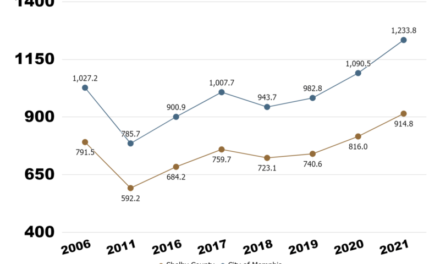Thumbnail: Now halfway to the year it set for its financial sustainability, Daily Memphian operated in 2019 at a $1.4 million deficit. Sustainability hinges on its success in reaching its goal of 25,000 subscribers, a 66% increase.
**
Daily Memphian spent $4.8 million in its first full year of operations and produced a $1.4 million deficit. It needs to increase subscriptions by 66% to become financially sustainable.
These financial realities suggest there may be no magic answer to the challenges facing today’s journalism and raises the question: is the Daily Memphian reinventing journalism, as it has often boasted, or is it merely the old Gannett Commercial Appeal under a nonprofit structure.
Daily Memphian’s first full year of operations was 2019 after launching in September, 2018. Asked about the losses, Publisher Eric Barnes said the newspaper is still “very much a start-up and was always projected to lose money through the first 4-5 years.” He said losses in 2020 were less than $1.4 million.
A 2017 statement filed with the IRS projected total expenses for 2019 and 2020 respectively at $3.1 and $3 million with salary costs of $2.1 and $2.2 million. Actual results outstripped the projections with expenses of $4.8 and salaries of $3.2 million. At that time, the Daily Memphian projected a loss of roughly $1.8 million in 2019 and $1.2 million in 2020. The 2020 IRS report has not been filed with the IRS.
One thing is clear. Daily Memphian’s ambitions are expansive – and expensive.
The Hunt For 25,000 Subscribers
In the past year, frequent calls for public contributions and subscribers seemed to indicate financial concerns but the pleas – perhaps coincidentally – seemed to lessen after the newspaper received $661,000 from the federal Paycheck Protection Program, funding it grudgingly acknowledged although it had reported on other companies’ funding.
Although the number of nonprofit journalism outlets are growing, only a few newspapers have launched with a staff as large and costly as the Daily Memphian. “Most people have started something like this – for profit or nonprofit – have started small and grown,” Mr. Barnes said at the launch of the newspaper. “We made the calculated decision that we would go big and launch with a really big staff, making a lot of noise by hiring talented, popular writers.”
He said the number of Daily Memphian subscribers is now approaching 15,000 and the goal “is still to get to 25,000 paid subscribers at a net rate of $10-11 per month” by the end of 2023. He said: “Hitting 25k is ‘only’ a matter of adding 3,000 new subs over the next three years. That seems doable to me.”
It seems a daunting, if not a life or death, goal – a 66% increase in subscribers. Financial sustainability is based on it, but Mr. Barnes’ is confident that over the next three to six months, “we’ll be getting a lot more sophisticated in how we target and convert casual readers.” “Among other things, right now, a visitor to the site gets 3 free (articles) per month, per device, and per browser on that device. So even if someone isn’t trying to ‘cheat’ the paywall, they can get a lot of stories for free. The new paywall features will help us trim down dramatically the number of free stories a casual reader gets.”
The Commercial Appeal has 10,100 digital-only subscribers, and including all-access subscribers, the newspaper has more than 35,000 digital users/subscribers, said Executive Editor Mark Russell. It has tripled the number of digital subscribers in three years.
Action and Reaction
Lack of transparency about its financial support has dogged the Daily Memphis since it began. It has been a barrier to membership in nonprofit news organizations and in pursuing some grants.
An article written by Poynter September 29 said: “A soft spot in The Daily Memphian profile, in my view, is that the source of its financing is less than fully transparent. Businessman Andy Cates led the launch effort and is chairman of its board and probably a major contributor.”
After I emailed Mr. Barnes my questions about the Daily Memphian’s IRS reports, it for the first time added to its website a list of donors who have given $1,000 or more. The Texas Tribune, a model for major nonprofit daily newspapers, lists its contributors and the amounts of their donations down to less than $10.
Following my inquiry, Daily Memphian also posted an IRS 990 report for the first time – the one for 2019 (the one from 2018 was not posted). By way of comparison, the Texas Tribune has posted every one of its 990s – and also its audits – back to 2009 when it was established. It also breaks down by percentage how much of its budget is funded by foundations, individuals, corporations, events, and memberships.
The Texas Tribune, rather than funding its newspaper with subscriptions, is supported by 4,500 members and contributors. Besides the news outlet, it also hosts 50 live events a year and the Texas Tribune Festival, which attracts thousands of people to Austin in what is called a “celebration of ideas.” It features a data section with public sector salaries, an economy tracker, higher education outcomes, and a listing of Death Row inmates.
Growing Nonprofit Outlets
Questions about editorial independence have also been persistent from Daily Memphian’s first days, stemming from its decision to stonewall requests for information about donors and about the influence by donors and board members have on coverage. After persistent comments about how some topics, places, and organizations seem to get outsized coverage (the latest appears to be the Overton Park golf course), Daily Memphian now has a section about “editorial independence” on its “About Us” page.
The newspaper seems aimed at readers midtown, the Poplar Corridor, and East Memphis. Its readers skew toward higher educational attainment (almost 70% have college degrees) with higher incomes overindexing at more than $100,000.
Mr. Barnes did not directly answer questions about why someone would subscribe now if they haven’t already and where he will find 10,000 new subscribers, but he said the challenge is to overcome the decades-long “habit and expectation that news should be free.”
Mr. Barnes would likely agree that the Daily Memphian has not achieved what he promised when it launched: “If the stories we write about don’t look like Memphis in all its complexity and diversity then we have failed.”
In rolling out its newspaper, Daily Memphian officials suggested they were inventing a new brand of journalism. The first nonprofit newspapers in the U.S. began in 1974 and 1976 and there were 172 about 35 years later. Most are publications with distinctive niches – we have some excellent ones here like MLK50, High Ground News, and Chalkbeat – and most have five or fewer staff members (78%).
The number of daily newspapers shifting to a nonprofit structure is growing but only a few have attempted it at the scale of Daily Memphian. It wasn’t until a year after Daily Memphian began that The Salt Lake Tribune became the first legacy newspaper to become nonprofit. Some years earlier, the Philadelphia Inquirer was given to Lenfest Foundation, a funder of the Daily Memphian, and it was followed by the Tampa Bay Times, which is owned by the Poynter Institute.
Proving that a nonprofit structure is no panacea, Tampa Bay Times has reduced staff and outsourced printing, costing 150 production jobs, and in Philadelphia, printing of the newspaper was outsourced, eliminating the jobs of 500 printers.
Tale of the Tape
In its 2018 IRS report, Memphis Fourth Estate Inc., the nonprofit umbrella for Daily Memphian, reported that it had startup funding of $6.7 million and expenses of $2.2 million for a net of $4.8 million in that partial year.
Its 2019 IRS report shows a surge in expenses to $4.8 million for its first full calendar year. With $3.5 million in revenues, it ended the year $1.4 million in the red. Two-thirds of the expenditures were for salaries. Mr. Barnes told Poynter that the Daily Memphian had 25 staff members at launch, which has grown to 35 with 20 freelancers.
Salaries listed in the report were Mr. Barnes at $150,000 (he is a “shared” CEO with the Daily News); chief technology officer Jason Israel, $152,000; columnist Geoffrey Calkins, $149,062; editor-in-chief James Overstreet, $130,867; and senior account executive Janice Jenkins, $118,697. This report was for the year before Ronnie Ramos was hired as executive editor and Elaine Sung as sports editor.
For 2019, the budget broke down this way: reporting, $3.1 million; advertising and events, $1 million; management and general, $743,902; and $28,305 for fundraising.
Financial Sustainability
Looking ahead, increasing subscribers will be key to the future of Daily Memphian. In a September 24 column, Mr. Barnes wrote: “I tell them that subscriptions are the most effective way for us to become financially sustainable.” Daily Memphian launched September, 2018, at a subscription rate of $7 and the first month free. Mr. Barnes promised at the launch that the subscription rate might go up but “we’re not going to go up dramatically.” The subscription rate increased to $11 about a year later.
As an indication of the challenge to reach sustainability, subscriptions for 2019 produced $804,014 in revenues, which would suggest fewer than 13,000 subscribers, but Mr. Barnes said: “We’re approaching 15,000 (14,827 as of a couple of hours ago) and a net monthly rate that averages close to $9.50. And our retention rates remain above 90% for subscribers after 12 months.”
If Daily Memphian can reach its goal of 25,000 subscribers in three years, it could produce more than $2.6 million in new revenues, which means at the present spending level, it could be in the black. However, conversely, it underscores that failing to reach the goal means Daily Memphian could face financial crisis.
It’s hard to believe the Daily Memphian is only two and a half years old because of its strong presence. Its launch featured chest-thumping by its principals and taunts at the Commercial Appeal which Gannett bought in late 2015. Following the purchase, Memphis’ legacy newspaper was adjusting to Gannett’s scheme to buy up enough Tennessee newspapers to create a state network with a Nashville hub.
It was far from seamless and produced some careless mistakes by Gannett, such as the Commercial Appeal’s Living Section cover story featuring a Nashville couple or the plaque in a Memphis contest with a Nashville background or the short story about a new Applebee’s in Knoxville.
The Skirmish
Within that context, Mr. Barnes was explicit about challenging his competitor in ways that implied they were not loyal to Memphis and unbiased, behaviors that attracted unflattering national attention. His newspaper’s “Truth in Place” was not only confusing but was taken as an insult by many of the CA’s young reporters. For them, the barbs were personal and gratuitous.
It was hard to escape the irony of the constant barbs about Gannett thrown by Daily Memphian in that it had hired 10 Commercial Appeal reporters, one former Commercial Appeal reporter, and a reporter from Gannett’s Jackson Sun – not to mention, it would later hire an executive editor from Gannett’s Indianapolis Star. As Mr. Russell reflected later, the CA “had to go out and get new players for almost every major position. And we did that and we got better.”
Despite losing much of his staff, Mr. Russell has staffed up with a group of younger reporters who give “Old Reliable” a unique voice. His 24 reporters include a second investigative reporter, a new food writer, and a new sports columnist. The voice of the Daily Memphian staff is more prosaic and any serious investigative journalism there comes through its $30,000 contract with the University of Memphis Institute of Public Service Reporting’s Distinguished Journalist in Residence Marc Perrusquia.
Ultimately, in defense of his team, Mr. Russell responded to NeimanLab a year ago: “Eric Barnes, Andy Cates, and even some of their columnists have said things in the media and said things publicly that have just been, I’ll call them , call it what it is, outright lies. Because they’re describing The Commercial Appeal and our commitment to Memphis and whether we’re controlled by Nashville. And they know that is a false narrative, and they keep repeating it. They’ve let up a little bit lately, as I’ve called them on it, but I think for almost a full year, that’s all they talked about, how the CA was ‘not committed to Memphis.’”
Former Commercial Appeal columnist Wendi Thomas summed it up this way: “Instead of raiding local publications, did the unnamed founders of this unnamed new/old venture ever consider recruiting new talent from outside of Memphis? I want every journalist who wants a job to have a job, but it feels like after the founder/philanthropist’s bid to buy the CA was rebuffed by Gannett (according to my sources, the founder got mad and decided to try to destroy the CA).”
Newspaper War
It’s always risky to predict the next moves for large newspaper chains, but Gannett’s fortunes have turned to the positive. In the last four months, its stock price has tripled, it has received a lower interest loan of $1 billion, and it is receiving positive predictions from Wall Street about its future. Hopefully, some of success will trickle down to individual newspapers in the form of more reporters, but more than anything, it indicates that Gannett is in Memphis for the long run.
As for nonprofit journalism, the jury is still out.
Nonprofit newspapers have brought a sense of hope in repairing the fraying fabric of American journalism, but as the Columbia Journalism Review wrote: “It’s important to stress that nonprofit status isn’t a silver bullet…more broadly, philanthropy is not always a sustainable business model and more inventive fixes aren’t commonly feasible at scale.”
Until the final verdict is delivered, all of us who value journalism and the reporters who deliver the news have something we haven’t had since the Memphis Press-Scimitar closed on Halloween, 1983 – a two newspaper town.
Who would have guessed that after 38 years, we would be the beneficiaries of a newspaper war?
***
Join us at the Smart City Memphis Facebook page for daily articles, reports, and commentaries relevant to Memphis.








